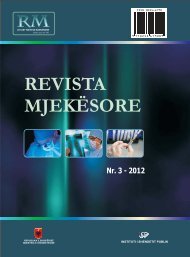in Albania - Instituti i Shendetit Publik
in Albania - Instituti i Shendetit Publik
in Albania - Instituti i Shendetit Publik
Create successful ePaper yourself
Turn your PDF publications into a flip-book with our unique Google optimized e-Paper software.
INTERNATIONAL PUBLIC HEALTH CONFERENCE IN TIRANA, ALBANIAStrategies for prevention of non-communicablediseasesDoncho Donev 11Institute of Social Medic<strong>in</strong>e, Faculty of Medic<strong>in</strong>e Ss Cyril and Methodius University <strong>in</strong> Skopje,Republic of Macedonia.Aim: To present two basic strategies for preventionof non-communicable diseases (NCDs) andtheir strengths and weaknesses.Methods: Start<strong>in</strong>g from the WHO EuropeanStrategy and Action Plan for prevention and controlof NCDs <strong>in</strong> the period of 2011-2015, an analysisof the relevant literature on experiences <strong>in</strong> manycountries <strong>in</strong> prevention of NCDs was conducted.Results: There are two basic strategies forprevention of NCDs: population strategy andstrategy for high-risk <strong>in</strong>dividuals. Population strategyis aimed at reduc<strong>in</strong>g the level of risk factors <strong>in</strong> all<strong>in</strong>dividuals <strong>in</strong> the general population through creat<strong>in</strong>gconducive environment that enables the adoption ofhealthy lifestyles and appropriate legislation, taxationand f<strong>in</strong>ancial <strong>in</strong>centives from the government.Although the effect is small at the <strong>in</strong>dividual level,the strategy has a large impact on population level,<strong>in</strong> particular it does not require behavioral changesand can give quick effects. Such strategies are oftenvery cost effective and can even generate profit. Itoffers achiev<strong>in</strong>g good for all. Strategy for high-risk<strong>in</strong>dividuals is aimed at detection and treatment ofhigh-risk <strong>in</strong>dividuals through screen<strong>in</strong>g (e.g. for highblood pressure) and treatment before complicationsoccur. It offers achiev<strong>in</strong>g large effects <strong>in</strong> a fewpeople, but has little impact on population level. Itrequires behavioral changes at the <strong>in</strong>dividual level(cooperation). Often the costs are high (drugs foryears for many patients), and it is possible to achievegood for some.Conclusion: The population strategy has severaladvantages, but <strong>in</strong> practice it is necessary to use acomb<strong>in</strong>ed approach for the detection and treatmentof high-risk <strong>in</strong>dividuals, too. It is necessary for theimplementation of the strategies to be followed byappropriate action plans for communication of theeffects to the overall population.Keywords: non-communicablediseases, high-risk <strong>in</strong>dividuals, populaiton strategy, prevention.ALBANIAN MEDICAL JOURNAL SUPPLEMENT11




